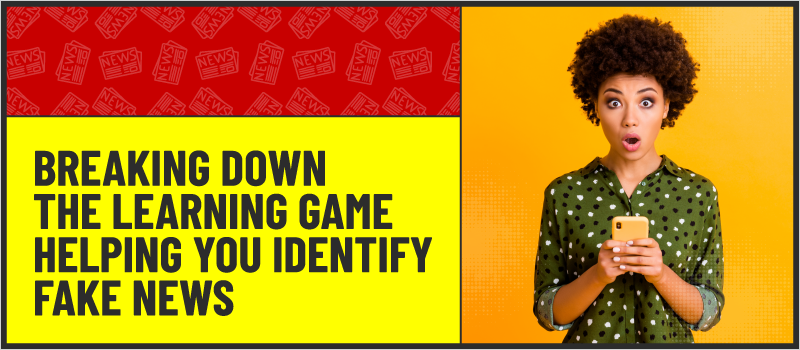
In a time when ‘fake news’ is prevalent across the internet, especially on social media platforms, it can be challenging to identify what is factual or fabricated. As an eLearning professional, I was intrigued to learn about a game developed by the University of Cambridge designed to address this pervasive and potentially dangerous social problem. The browser based game, Bad News, was designed and tested as a digital vaccine to decrease a player’s susceptibility to disinformation.
According to the University of Cambridge, people who played Bad News were on average 21% less likely to perceive fake news as reliable than they were before playing the game.
It taught those who played the game how to critically examine fake news headlines to better discern whether they were fact or fiction. As I played Bad News myself, I discovered an array of game development and rhetorical techniques that could be effectively used in gamified eLearning, especially when teaching abstract concepts such as leadership, critical thinking, and communication.
Take a look at how these techniques could be applied in your eLearning development:
Voice and Tone
People naturally become defensive when they feel their beliefs are challenged, so it is important to create a safe environment where learners feel comfortable enough to engage with sensitive material. As I played Bad News, I found myself chuckling at the narrator’s witty remarks and the ridiculous learner response options. More than once, I found myself choosing the most unlikely response just to see what would happen. The comedic-casual tone kept me engaged throughout the game and encouraged me to fully explore and understand the concept by rewarding my exploration with comedy.
The tone also made me feel safe to answer “wrong.” I actually “lost” the game when I first played by taking the route based on moral objections towards spreading disinformation. But because the game acknowledged that spreading disinformation was morally wrong and kept a humorous tone, I was eager to explore further, and felt more comfortable immersing myself in the role the second time I played.
Branching Scenarios
Unlike many standard linear eLearning scenarios, the scenarios in Bad News used video game branching techniques to promote critical thinking and encourage replay. Rather than simply selecting a response and receiving feedback, I felt like I was “creating” the scenario and observing the direct effect of my choices. By explaining the results of the choices I made, I learned real-world application for the abstract informational theories the game was teaching. By reflecting on my choices and results, my growing understanding of the tactics for spreading fake news increasingly helped me better identify disinformation.
Writing complex branching in eLearning can be time and resource intensive, but Bad News cleverly reduced the development load by repurposing feedback and limiting paths. When I played the game for a third time, I noticed I often received the same feedback for different choices. Many of the simulated tweeted feedback was reused for multiple selections, and sometimes the narrator's response was written so that it could be used for both options. This repurposed feedback goes unnoticed in a first play-through, and doesn’t detract much even in replay because they still affect your scoring and outcome differently.
Gamification
When telling a story in a video game, the mechanics of the game are at least as important as the narrative itself. Bad News beautifully integrated the narrative and gamification elements to immerse learners and subtly instruct them on identifying disinformation. Gamification elements included badges, number of followers, credibility meter, and challenge a friend.
The combination of earning followers, a credibility meter, and narrative were this game’s instructional workhorses, because they motivated me to cognitively engage with the content. Specifically, they informed me of possible motivations behind why someone would spread disinformation.
By measuring success in increased social credibility and number of followers, I found myself artificially valuing those metrics (and empathizing with others who really do value them). This empathy was reinforced by the narrator and character choices that emphasized the importance of followers, influence, and power. Additionally, I was motivated to carefully think through my responses and choose an answer to raise my score. After experiencing the motivations and rewards of a fake news tycoon, I better understood why someone would want to create fake news, how easy it can be to spread disinformation, and the tactics they could employ to make it seem real.
The icing on the cake were the game’s badges and “challenge a friend” option. The badges served as guideposts, dividing the game’s freeform structure into distinct lessons. They also summarized the key learning objectives without breaking the narrative. The “challenge a friend” choice at the end of the game engaged my competitive instincts to replay the game and achieve a higher score, and it inspired me to share the game to a wider audience.
Conclusion
In summary, the Bad News educational game allowed me to empathize with an unfamiliar role and learn about disinformation strategies through trial and error. It used gamification (meters, badges, and social competition), a comic-casual tone, false branching, immersive narrative, scenario building, and character roles to create an immersive and cognitively engaging learning experience. I encourage you to play the game yourself, keeping your next eLearning project in mind as you play.
- Play Bad News: https://www.getbadnews.com/#intro
- Learn more about Cambridge’s research: Fake news ‘vaccine’ works: ‘pre-bunk’ game reduces susceptibility to disinformation








